Hinton Charterhouse
| Hinton Charterhouse | |
| Pub, post office & general store in village centre |
|
 Hinton Charterhouse |
|
| Population | 515 [1] |
|---|---|
| OS grid reference | ST775585 |
| Unitary authority | Bath and North East Somerset |
| Ceremonial county | Somerset |
| Region | South West |
| Country | England |
| Sovereign state | United Kingdom |
| Postcode district | BA2 |
| Police | Avon and Somerset |
| Fire | Avon |
| Ambulance | South Western |
| EU Parliament | South West England |
| UK Parliament | North East Somerset |
Coordinates: 51°19′32″N 2°19′25″W / 51.3256°N 2.3235°W
Hinton Charterhouse is a small village and civil parish in the Bath and North East Somerset unitary authority, Somerset, England. The parish, which includes the village of Midford, has a population of 515.[1]
The village is served by two pubs: the Stag Inn and the Rose & Crown,[2] a vehicle repair garage; Charterhouse Works and Fortnum & Jacob, the local stores and post office.
The local paper is the occasionally published Hinton Bugler.
History
The parish of Charterhouse Hinton was part of the Wellow Hundred.[3]
The chapter house with library and dovecote above, of the former Carthusian Hinton Priory dates from 1232 and is a Grade I listed building.[4] The priory was founded in 1232 by Ela, Countess of Salisbury, who also founded Lacock Abbey.[5]
During the Second World War, GHQ Line ran just to the north of Hinton Charterhouse. At (Hedge) Hog Wood remains of an anti-tank ditch and other trenchworks can still be seen. These rare survivors as well as rather more robust pillboxes were constructed as a part of British anti-invasion preparations.[6]
The Grade II listed former village school is now a private residence. [7]
Governance
The parish council has responsibility for local issues, including setting an annual precept (local rate) to cover the council’s operating costs and producing annual accounts for public scrutiny. The parish council evaluates local planning applications and works with the local police, district council officers, and neighbourhood watch groups on matters of crime, security, and traffic. The parish council's role also includes initiating projects for the maintenance and repair of parish facilities, such as the village hall or community centre, playing fields and playgrounds, as well as consulting with the district council on the maintenance, repair, and improvement of highways, drainage, footpaths, public transport, and street cleaning. Conservation matters (including trees and listed buildings) and environmental issues are also of interest to the council.
The parish falls within the unitary authority of Bath and North East Somerset which was created in 1996, as established by the Local Government Act 1992. It provides a single tier of local government with responsibility for almost all local government functions within its area including local planning and building control, local roads, council housing, environmental health, markets and fairs, refuse collection, recycling, cemeteries, crematoria, leisure services, parks, and tourism. It is also responsible for education, social services, libraries, main roads, public transport, trading standards, waste disposal and strategic planning, although fire, police and ambulance services are provided jointly with other authorities through the Avon Fire and Rescue Service, Avon and Somerset Constabulary and the Great Western Ambulance Service.
Bath and North East Somerset's area covers part of the ceremonial county of Somerset but it is administered independently of the non-metropolitan county. Its administrative headquarters is in Bath. Between 1 April 1974 and 1 April 1996, it was the Wansdyke district and the City of Bath of the county of Avon.[8] Before 1974 that the parish was part of the Bathavon Rural District.[9]
The parish is represented in the House of Commons of the Parliament of the United Kingdom as part of North East Somerset. It elects one Member of Parliament (MP) by the first past the post system of election. It is also part of the South West England constituency of the European Parliament which elects seven MEPs using the d'Hondt method of party-list proportional representation.
Geography
Hinton Charterhouse Field is a 0.32 hectare biological Site of Special Scientific Interest (SSSI).[10] and Hinton Charterhouse Pit is a 0.4 hectare geological Site of Special Scientific Interest.[11]
Religious sites
The Church of St John the Baptist dates from the 12th century and is Grade II* listed.[12]
References
- ↑ 1.0 1.1 "Hinton Charterhouse Parish". Neighbourhood Statistics. Office for National Statistics. Retrieved 31 December 2013.
- ↑ Rose & Crown
- ↑ "Somerset Hundreds". GENUKI. Retrieved 22 October 2011.
- ↑ "The chapter house". Images of England. Retrieved 20 November 2006.
- ↑ Scott, Shane (1995). The hidden places of Somerset. Aldermaston: Travel Publishing Ltd. pp. 18–19. ISBN 1-902007-01-8.
- ↑ Foot, 2006, pp 283-288.
- ↑ "10 charming converted schools for sale". Daily Telegraph.
- ↑ "The Avon (Structural Change) Order 1995". HMSO. Retrieved 9 December 2007.
- ↑ "Bathavon RD". A vision of Britain Through Time. University of Portsmouth. Retrieved 4 January 2014.
- ↑ English Nature citation sheet for the site (accessed on 16 July 2006)
- ↑ English Nature citation sheet for the site (accessed 11 July 2006)
- ↑ "Church of St John the Baptist". Images of England. Retrieved 20 November 2006.
Further reading
- Foot, William (2006). Beaches, fields, streets, and hills ... the anti-invasion landscapes of England, 1940. Council for British Archaeology. ISBN 1-902771-53-2.
External links
| Wikimedia Commons has media related to Hinton Charterhouse. |
